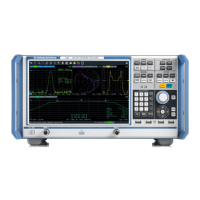Concepts and Features
R&S
®
ZNB/ZNBT
213User Manual 1173.9163.02 ─ 53
●
Eye Width
This result indicates the effects of jitter in reducing the horizontal eye opening. It is
defined as "Bit Period" - 2 · 3 · "Jitter RMS".
●
Bit Period
The inverse of the data rate.
●
Rise Time and Fall Time
The time it takes the rising (falling) edge of the eye to go from x% (y%) of the "Eye
Amplitude" to y% (x%) of the "Eye Amplitude" (0≤x≤y≤100, typically x=10 and
y=90).
●
Jitter Pk-Pk/RMS
These values measure the excursion of the 50% point of the rising edge in the hori-
zontal (time) direction: "Jitter Pk-Pk" is the distance between the peak values; "Jit-
ter RMS" is the RMS value of the excursions.
●
Duty Cycle Dist/Pct
These values measure the time separation between the rising and falling edge at
the 50% level of the eye diagram. "Duty Cycle Dist" is the absolute distance, "Duty
Cycle Pct" gives the same value as a percentage of the "Bit Period".
●
Crossing Percent
The Crossing Height is the height above "Eye Base" where the rising and falling
edges cross, "Crossing Percent" gives the same value as a percentage of the "Eye
Amplitude".
●
Opening Factor
This is a measure of the effects of amplitude noise on the vertical eye opening.
Accordingly, it is equal to
(("Eye Top" - σ
Top
) - ("Eye Base" + σ
Base
)) / "Eye Amplitude"
●
SNR
Relates the "Eye Amplitude" to the noise level. Accordingly, it is equal to
"Eye Amplitude" / (σ
Top
+ σ
Base
)
Eye diagram results are only available for NRZ modulated signals.
Eye Mask Test
Furthermore, the eye diagram simulation allows to perform tests against a user-defined
eye mask:
Figure 5-16: User-defined Eye Mask
Optional Extensions and Accessories

